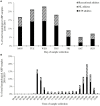Ten years of collecting hematological athlete biological passport samples-perspectives from a National Anti-doping Organization
- PMID: 35928963
- PMCID: PMC9343672
- DOI: 10.3389/fspor.2022.954479
Ten years of collecting hematological athlete biological passport samples-perspectives from a National Anti-doping Organization
Abstract
The hematological module of the Athlete Biological Passport (ABP) aims to reveal blood doping indirectly by looking at selected biomarkers of doping over time. For Anti-Doping Organizations (ADOs), the ABP is a vital tool in the fight against doping in sports through improved target testing and analysis, investigations, deterrence, and as indirect evidence for use of prohibited methods or substances. The physiological characteristics of sport disciplines is an important risk factor in the overall risk assessment and when implementing the hematological module. Sharing of experiences with implementing the hematological ABP between ADOs is key to further strengthen and extend its use. In this study, we present 10 years of experience with the hematological ABP program from the perspectives of a National ADO with special attention to sport disciplines' physiological characteristics as a potential risk factor for blood doping. Not surprisingly, most samples were collected in sport disciplines where the aerobic capacity is vital for performance. The study highlights strengths in Anti-Doping Norway's testing program but also areas that could be improved. For example, it was shown that samples were collected both in and out of season in a subset of the data material that included three popular sports in Norway (Cross-Country Skiing, Nordic Combined, and Biathlon), however, from the total data material it was clear that athletes were more likely to be tested out of competition and on certain days of the week and times of the day. The use of doping control officers with a flexible time schedule and testing outside an athlete's 60 min time-slot could help with a more even distribution during the week and day, and thus reduce the predictability of testing. In addition to promoting a discussion on testing strategies, the study can be used as a starting point for other ADOs on how to examine their own testing program.
Keywords: ABP; ADO; anti-doping; blood doping; risk assessment; sport; test distribution plan; test statistics.
Copyright © 2022 Bækken, Holden, Gjelstad and Lauritzen.
Figures



Similar articles
-
The Athlete Biological Passport: an integral element of innovative strategies in antidoping.Br J Sports Med. 2014 May;48(10):817-9. doi: 10.1136/bjsports-2014-093560. Epub 2014 Mar 21. Br J Sports Med. 2014. PMID: 24659508
-
The Athlete Biological Passport: How to Personalize Anti-Doping Testing across an Athlete's Career?Med Sport Sci. 2017;62:107-118. doi: 10.1159/000460722. Epub 2017 Jun 2. Med Sport Sci. 2017. PMID: 28578329
-
Monitoring of biological markers indicative of doping: the athlete biological passport.Br J Sports Med. 2014 May;48(10):827-32. doi: 10.1136/bjsports-2014-093512. Epub 2014 Mar 21. Br J Sports Med. 2014. PMID: 24659506 Review.
-
Comparison between standard hematological parameters and blood doping biomarkers in dried blood spots within the athlete population of Swiss Sport Integrity.Front Sports Act Living. 2024 Sep 19;6:1452079. doi: 10.3389/fspor.2024.1452079. eCollection 2024. Front Sports Act Living. 2024. PMID: 39364095 Free PMC article.
-
Do athletes have a right to access data in their Athlete Biological Passport?Drug Test Anal. 2018 May;10(5):802-806. doi: 10.1002/dta.2380. Epub 2018 Apr 20. Drug Test Anal. 2018. PMID: 29524351 Review.
Cited by
-
Trends in dietary supplement use among athletes selected for doping controls.Front Nutr. 2023 Mar 15;10:1143187. doi: 10.3389/fnut.2023.1143187. eCollection 2023. Front Nutr. 2023. PMID: 37006918 Free PMC article.
-
Establishing Personalized Blood Protein Reference Ranges Using Noninvasive Microsampling and Targeted Proteomics: Implications for Antidoping Strategies.J Proteome Res. 2024 May 3;23(5):1779-1787. doi: 10.1021/acs.jproteome.4c00020. Epub 2024 Apr 24. J Proteome Res. 2024. PMID: 38655860 Free PMC article.
-
Bioanalytical methods in doping controls: a review.Bioanalysis. 2025 Mar;17(5):359-370. doi: 10.1080/17576180.2025.2460951. Epub 2025 Feb 7. Bioanalysis. 2025. PMID: 39916648 Review.
References
-
- Batista M. M., Paludo A. C., Gula J. N., Pauli P. H., Tartaruga M. P. (2020). Physiological and cognitive demands of orienteering: a systematic review. Sport Sci. Health 16, 591–600. 10.1007/s11332-020-00650-6 - DOI
-
- Borjesson A., Lehtihet M., Andersson A., Dahl M. L., Vicente V., Ericsson M., et al. . (2020). Studies of athlete biological passport biomarkers and clinical parameters in male and female users of anabolic androgenic steroids and other doping agents. Drug Test. Anal. 12, 514–523. 10.1002/dta.2763 - DOI - PubMed
LinkOut - more resources
Full Text Sources

